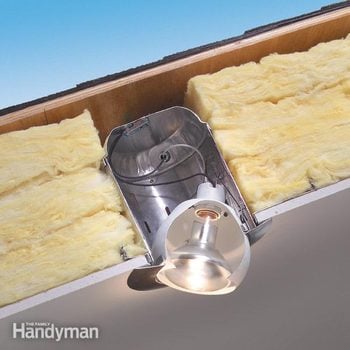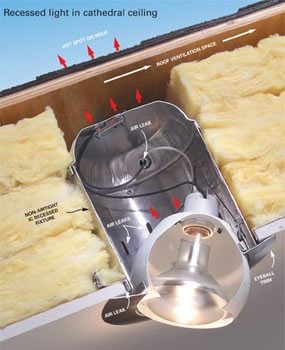How to Use Insulated Can Lights in Ceilings
Updated: Feb. 09, 2024How an airtight recessed fixture saves energy and protects your roof for optimum cathedral ceiling lighting.

Avoid heat loss with cathedral ceiling lighting
If you’re concerned about heat loss through your recessed lights in a cathedral ceiling, turn off the light, unscrew the bulb and remove the trim to check the label inside. Your fixtures aren’t airtight unless they have an “airtight” rating. But don’t simply plug the holes to make it tighter (see photo). Manufacturers submit fixtures to Underwriter’s Laboratories (UL) to receive a safety rating for their designated use. (You’ll see a UL rating somewhere on the fixture.) Altering the fixture in any way may compromise its margins for safety.
This is a real issue. Recessed lights in cathedral ceiling lighting waste the heat from the light bulb and the warm air that leaks through the fixture. Even worse, moist, warm air will flow up against the cold roof sheathing (see photo). Chances are that it’ll condense there, wet the wood and eventually cause rot. Unfortunately, there isn’t any easy way to know if you have moisture problems and rot until you find water dripping from the vaulted ceiling recessed lighting, stains or soft spots in the drywall. The fix is expensive.
Builders often try to prevent the problem by leaving a 1- to 2-in. airspace for roof ventilation. Roof venting can help dry the wood again in warmer weather, and it’ll flush out some of the moisture in cold weather. But it often doesn’t work well.
The best solution is to avoid putting any recessed lights in cathedral ceilings. However, if you want them, use type IC “airtight” fixtures (available at lighting stores and home centers). These fixtures are sealed to stop airflow. In addition, they have gasketed edges to seal them to the drywall.
Replacement can be challenging. If you’re lucky, you can pull the old mounting bracket out through the existing hole. Otherwise you have to tear open the ceiling. We recommend that you hire a licensed electrician for this tricky job.
Vaulted Ceiling Can Lights: Airtight Recessed Fixture
Airtight fixtures will be labeled. You can use a remodeling type to replace non-airtight fixtures. Usually they will be IC rated (insulation contact) as well.

